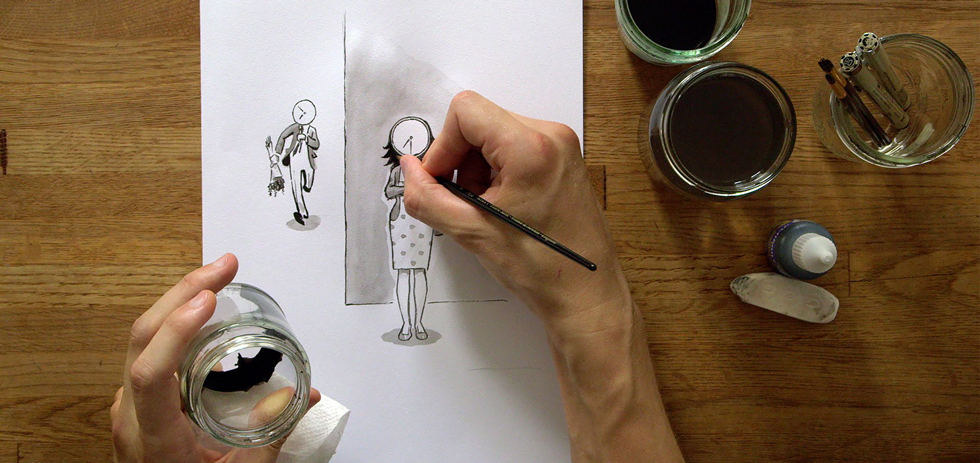
If you’re anything like me, the first thing you do when you open an issue of The New Yorker is look at the cartoons. Whether satirical, directly political, wryly observant, or just plain absurd, a New Yorker cartoon can provide an instant, insightful take on current events that’s more relevant and often funnier than the quips that pepper most late-night television monologues. The cartoons were there in the first issue, in February of 1925, and they’ve been given pride of place ever since. In fact, until the early ’90s, when the magazine began including photographs, cartoons were the only graphics anywhere in its pages. An amusing new documentary scrutinises these funny little drawings, looking at the history of the art form and the kinds of people, past and present, who are wired in just the right way so as to become expert at it.
The film’s central subject is the magazine’s Cartoon Editor, Bob Mankoff, who, as it happens, looks a bit like a cartoon himself. Most of the interviews with him were done in the lead-up to the publication, early last year, of his memoir, How About Never — Is Never Good For You?, and part of the film is given over to examining his writing process. As such, though it touches on a range of topics, Very Semi-Serious is specifically about cartoonists and their work for The New Yorker. Weekly pitch meetings, in which freelancers visit Mankoff’s office with a dozen or so drawings in hand, provide the most insight into the magazine’s process, and old masters such as Mort Gerber, Lee Lorenz, and Sam Gross give light to historical context. There’s some discussion of the wider magazine industry as it relates to cartooning, but this doesn’t expand beyond a simplistic comment that The New Yorker is one of the only remaining magazines printing cartoons — far from the hay-day, we’re told, of the 1970s, when there were dozens of titles and therefore multiple comic modes, from the crass to the high-minded, that artists could work in.
Contemporary freelancers such as Bruce Eric Kaplan, Matt Diffee, Farley Katz, and Roz Chast lay out what it’s like to be a cartoonist these days, juggling day jobs and other commitments with the need to get in the right frame of mind to actually do the work they love. Chast is a particularly entertaining character, commenting on her innate shyness, which was heightened by her being the only woman cartoonist at the magazine when she began in the late ’90s.1 Chast was the start of what might be labelled a ‘new guard’ of talent brought in by Mankoff and Remnick, not just in cartooning but across the board.2
The film’s most entertaining and informative strand involves three newcomers taken as case studies. The distinctive, individualistic work of Emily Flake, Liana Finck, and Edward Steed whole-heartedly embody a notion of Mankoff’s about the magazine’s cartoons in general: that they “make the familiar strange, and the strange familiar.” Flake is a relatively straightforward character, and makes some interesting comments on her new motherhood beginning to affect her comic sensibilities. Finck’s work draws heavily on her graphic-novel background, and Mankoff seems to take a particular liking to her. He appears completely fascinated by her extreme shyness and beguilingly timid voice, which she labels “wobbly” and amusingly attributes to Asperger’s. Near film’s end we’re introduced to Edward Steed, a prolific young cartoonist who discovered the magazine only a few years ago while travelling in Vietnam. His Steadman-esque drawings, which he produces dozens of each week, animate Mankoff to such a degree that, without hesitation, he labels the young man a genius.
The film’s focus is narrow and self-contained, in the sense that only current staff at the magazine are interviewed — a set piece near the end shows Remnick approving the next issue’s cartoons — thus making it a good companion piece to Page One, Andrew Rossi’s 2011 film about the New York Times. Very Semi-Serious maintains a brisk pace for about an hour but loses some steam in its last section as it concentrates a little too much on a recent bereavement of Mankoff’s, and unnecessarily goes along for the ride as the magazine (and the rest of Condé Nast) moves offices from Times Square to the newly completed One World Trade Center. That location is cause, however, for quiet introspection and some rumination on the near-canonical formula of comedy being ‘tragedy plus time.’
Though famous cartoonists who drew for the magazine are mentioned — William Steig, Peter Arno, and Charles Addams (of Addams Family fame) among them — not nearly enough of this archived history is exposed. Indeed, more industry talk generally, especially some comment on the technological shift of the past decade, would have made the film a more robust and well-rounded document. As it stands, Very Semi-Serious is a remarkably entertaining, if slender, diversion.
